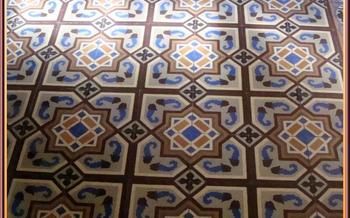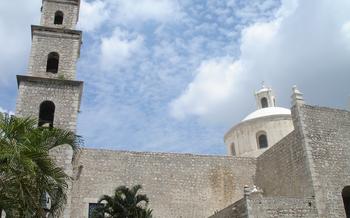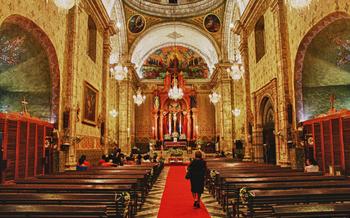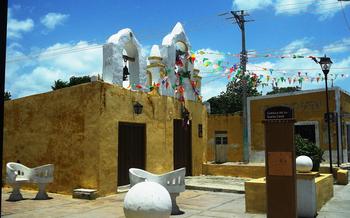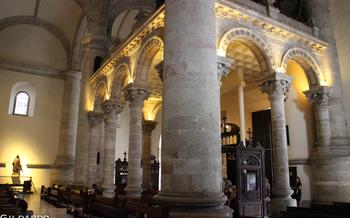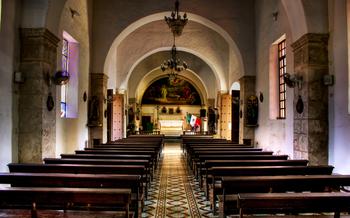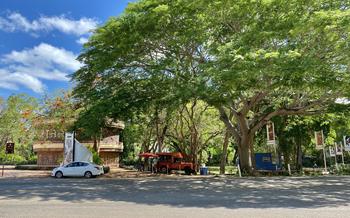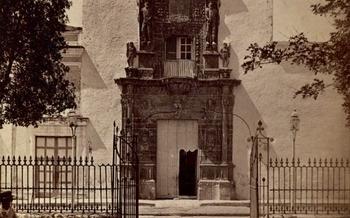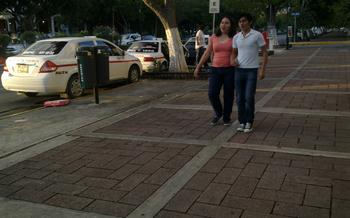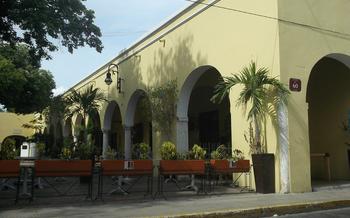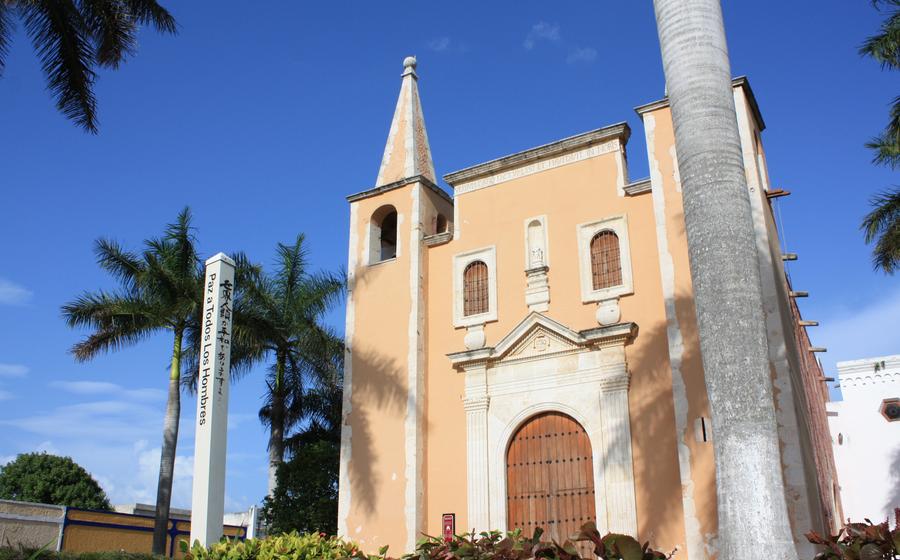
Templo de Santa Ana
- Architectural Beauty
- Religious Significance
- Cultural Impact
- Visiting the Temple
- Exploring the Neighborhood
- Photography Opportunities
- Historical Context
- Restoration and Preservation Efforts
- Art and Artifacts
- Local Cuisine
- Shopping and Souvenirs
- Family-Friendly Activities
- Insider Tip: Discovering the Hidden Courtyard of Casa de las Muñecas
Architectural Beauty
The Templo de Santa Ana stands out for its remarkable architectural beauty, a testament to the skill and artistry of its builders. The facade is a masterpiece of Renaissance-style architecture, showcasing intricate carvings, sculptures, and reliefs that depict biblical scenes and stories. The church's grand entrance, flanked by two bell towers, is particularly impressive, inviting visitors to step inside and explore the wonders within.
The interior of the Templo de Santa Ana is equally stunning, with its vaulted ceilings, stained glass windows, and ornate altarpieces creating an awe-inspiring atmosphere. The main altar, dedicated to Saint Anne, is a masterpiece of Baroque art, adorned with intricate carvings, gold leaf, and colorful paintings. The church's many side altars, each dedicated to a different saint or religious figure, are also beautifully decorated with sculptures, paintings, and votive offerings.
One of the unique architectural features of the Templo de Santa Ana is its octagonal dome, which crowns the central crossing of the church. The dome's interior is decorated with vibrant frescoes depicting scenes from the life of Jesus and the Virgin Mary. The dome's exterior is equally impressive, with its intricate tilework and elaborate moldings that add to the overall grandeur of the church.
Religious Significance
The Templo de Santa Ana holds a deep religious significance for Catholics in Mexico, serving as a place of worship and pilgrimage. The church is dedicated to Saint Anne, the mother of the Virgin Mary, who is highly revered in the Catholic tradition. Devotees from all over the country flock to the temple to pay homage to Saint Anne and seek her intercession. The annual Fiesta de Santa Ana, held on July 26th, is a major religious event that draws thousands of pilgrims to Merida. During the festival, the church is adorned with colorful decorations, and special masses and processions are held to honor the saint. The Fiesta de Santa Ana is a vibrant display of faith and devotion, showcasing the deep connection between the local community and the Templo de Santa Ana.
Cultural Impact
The Templo de Santa Ana has had a profound impact on the cultural landscape of Merida and the Yucatan region. As a place of worship, it has played a central role in promoting local traditions and customs. The church has been a venue for religious festivals, processions, and other cultural events throughout history. It has also served as a gathering place for the community, where people come together to celebrate, socialize, and share their traditions.
The Templo de Santa Ana has been a source of inspiration for local artists, musicians, and writers. Its stunning architecture and rich history have been captured in paintings, sculptures, and literary works. The church has also been a catalyst for the development of local crafts and صنایع دستی. Many local artisans create religious objects, such as candles, incense, and statues, which are sold in the church and the surrounding markets.
The Templo de Santa Ana is a living testament to the cultural heritage of Merida and the Yucatan region. It is a place where history, tradition, and faith come together to create a vibrant and dynamic cultural landscape.
Visiting the Temple
Visiting the Templo de Santa Ana is a must-do for anyone interested in history, architecture, or religion in Merida. The church is open to the public daily, and admission is free. Guided tours are available in English and Spanish for a small fee. The best time to visit is during the morning or late afternoon to avoid the heat and crowds. Visitors can take their time to admire the church's exterior and interior, learn about its history and significance, and even attend a mass or a special event. There are also restrooms and a gift shop located on the premises for the convenience of visitors.
Exploring the Neighborhood
The Templo de Santa Ana is situated in the heart of the historic neighborhood of Santiago, which offers a vibrant blend of colonial charm and modern-day conveniences. As you wander through the cobblestone streets, you'll be greeted by a kaleidoscope of colorful buildings, charming boutiques, and local markets.
Take a leisurely stroll down Calle 60 to discover the Mercado de Santiago, a bustling marketplace where you can find everything from fresh produce and spices to handmade crafts. Be sure to sample some of the local delicacies, such as cochinita pibil, a traditional pork dish slow-cooked in banana leaves.
For a glimpse into the neighborhood's rich history, visit the Museo de la Ciudad de Merida, housed in a beautifully restored colonial mansion. Here, you'll learn about the city's fascinating past and its role as a cultural crossroads.
Santiago is also home to several other notable landmarks, including the Plaza Grande, the Catedral de San Ildefonso, and the Palacio de Gobierno. Take some time to explore these architectural gems and soak up the vibrant atmosphere of this historic neighborhood.
Photography Opportunities
The Templo de Santa Ana is a dream come true for photography enthusiasts, offering a wealth of captivating angles and lighting conditions to capture its architectural splendor. The intricate carvings and sculptures on the facade are a testament to the skill of the artisans who created them, providing endless opportunities for close-up shots and detailed compositions. The interior of the church is equally impressive, with its vaulted ceilings, stained glass windows, and ornate altarpieces providing a feast for the eyes. For the best results, aim to visit the temple during the golden hours of sunrise or sunset, when the warm light casts a magical glow on the building's exterior. Don't forget to explore the surrounding neighborhood of Santiago, with its charming streets, colorful buildings, and vibrant markets offering a glimpse into the daily life of the locals. Remember to be respectful of the local culture and customs, and ask permission before photographing people or religious ceremonies.
Historical Context
The city of Merida and the broader Yucatan region are steeped in a rich and captivating history, with the Templo de Santa Ana serving as a testament to the region's storied past. Founded in 1542, Merida played a pivotal role as the capital of the Spanish colonial province of Yucatan. During this era, the city experienced a remarkable transformation, with the construction of grand cathedrals, monasteries, and government buildings that showcased the influence of Spanish architecture and culture. The Templo de Santa Ana stands as a prominent example of this architectural legacy, reflecting the fusion of European and Mayan design elements that characterized the colonial period.
Throughout its history, the Yucatan region has witnessed numerous significant events and been shaped by influential figures. The ancient Maya civilization left an enduring mark on the region, with their impressive cities, sophisticated writing system, and advanced mathematical knowledge. The arrival of the Spanish conquistadors in the 16th century ushered in a new era, marked by both conflict and cultural exchange. The region's rich history is further enriched by the contributions of notable figures, such as Francisco de Montejo, the Spanish conquistador who founded Merida, and Felipe Carrillo Puerto, a revolutionary socialist governor who championed the rights of the Maya people.
Restoration and Preservation Efforts
The Templo de Santa Ana has undergone several restoration and preservation efforts throughout its history. In the early 19th century, the church underwent extensive renovations, including the addition of the neoclassical facade and the bell tower. In the late 20th century, a major restoration project was undertaken to address structural damage and deterioration caused by age and neglect. This project involved reinforcing the foundations, repairing the roof, and restoring the interior and exterior of the church.
The restoration team faced several challenges, including the need to preserve the church's original features while also addressing the structural issues. They carefully removed and restored the original stonework, repaired the intricate carvings and sculptures, and replaced the damaged stained glass windows. The project also involved the installation of new lighting and sound systems to enhance the visitor experience.
Thanks to the dedication and expertise of the restoration team, the Templo de Santa Ana has been successfully preserved for future generations. It now stands as a testament to the city's rich history and cultural heritage, and continues to serve as a place of worship and inspiration for the people of Merida.
Art and Artifacts
The Templo de Santa Ana is home to a treasure trove of significant works of art and religious artifacts that reflect the rich cultural heritage of Merida and the Yucatan region. Among the highlights is the stunning main altarpiece, a masterpiece of Baroque craftsmanship that depicts scenes from the life of Saint Anne, the patron saint of the church. The intricate carvings and gilded details of the altarpiece are a testament to the skill and artistry of the local artisans who created it.
Another must-see is the collection of 17th-century paintings that adorn the walls of the church. These paintings, which depict various religious scenes and figures, offer a glimpse into the artistic styles and techniques of the colonial era. Visitors can also admire the beautiful stained glass windows that filter colorful light into the church's interior, creating a serene and contemplative atmosphere.
In addition to these larger works of art, the Templo de Santa Ana also houses a number of smaller artifacts that are of historical and cultural significance. These include silver chalices, ornate candlesticks, and intricately carved wooden sculptures. Each of these objects tells a story about the church's history and the faith of the people who have worshipped within its walls.
To enhance visitors' appreciation of the church's art and artifacts, guided tours are available that provide insights into the history, symbolism, and significance of these treasures. Visitors can also learn more through exhibits and educational materials that are displayed in the church's museum.
Local Cuisine
In the neighborhood of Santiago, where the Templo de Santa Ana resides, visitors can indulge in the culinary delights of Yucatecan cuisine. This region of Mexico is renowned for its unique blend of Mayan and Spanish flavors, creating dishes that are both vibrant and delicious. A must-try for any visitor is cochinita pibil, a slow-roasted pork dish cooked in banana leaves with achiote paste. Panuchos, thick tortillas filled with black beans and topped with cochinita pibil, are another local favorite. For a lighter option, try papadzules, corn tortillas filled with eggs and pumpkin seed sauce. These dishes can be found in restaurants and street food stalls throughout the neighborhood, offering a taste of the region's rich culinary heritage. As you savor these delectable dishes, you'll not only satisfy your taste buds but also gain a deeper appreciation for the cultural influences that have shaped this vibrant region.
Shopping and Souvenirs
The Templo de Santa Ana and its surrounding neighborhood offer a treasure trove of unique and authentic souvenirs for visitors to take home. Within the church itself, visitors can find a variety of religious items, such as candles, rosaries, and small statues of saints. These items are not only beautiful but also hold deep cultural and spiritual significance for the local community.
Stepping outside the church, visitors will find themselves immersed in a vibrant array of shops and stalls selling traditional Yucatecan handicrafts, textiles, and souvenirs. These items are often handmade by local artisans, using techniques that have been passed down through generations. Visitors can find everything from colorful hammocks and hand-woven rugs to intricate pottery and embroidered clothing.
One of the most popular souvenirs is the huipil, a traditional Mayan blouse known for its vibrant colors and intricate embroidery. Visitors can also find a variety of other textiles, such as shawls, tablecloths, and napkins, all adorned with unique and beautiful designs.
For those looking for something truly special, the neighborhood is home to several silversmiths who create exquisite jewelry using traditional techniques. Visitors can find a variety of pieces, from delicate earrings and necklaces to elaborate headdresses and brooches, all handcrafted with intricate detail.
Whether you're looking for a meaningful religious memento, a unique piece of art, or a special gift for a loved one, the Templo de Santa Ana and its surrounding neighborhood offer a wealth of shopping opportunities that are sure to delight and inspire.
Family-Friendly Activities
The Templo de Santa Ana and the surrounding neighborhood of Santiago offer a range of family-friendly activities that cater to visitors of all ages. Guided tours are available for both the church and the neighborhood, providing an informative and engaging experience for children and adults alike. Scavenger hunts are also a popular option, allowing families to explore the area while solving puzzles and learning about its history.
For a more hands-on experience, visitors can participate in educational workshops that teach traditional crafts and skills, such as pottery, weaving, and cooking. Many of these workshops are specifically designed for children, providing them with a fun and interactive way to learn about the local culture.
Stroller rentals are available for families with young children, and changing tables can be found in the church and nearby restaurants. Kid-friendly menus are offered at several restaurants in the area, ensuring that everyone can find something they enjoy.
Overall, the Templo de Santa Ana and the neighborhood of Santiago provide a safe and enriching experience for families. With its historical significance, cultural attractions, and family-friendly activities, it is a great place for families to explore and learn together.
Insider Tip: Discovering the Hidden Courtyard of Casa de las Muñecas
As you wander through the charming neighborhood of Santiago, take a moment to seek out a hidden gem tucked away just steps from the Templo de Santa Ana: the Casa de las Muñecas. This beautifully preserved colonial mansion, adorned with intricate tilework and colorful facades, is a hidden treasure that offers a glimpse into Merida's rich history and architectural heritage.
Step through the unassuming entrance and be transported to a secluded courtyard, a tranquil oasis amidst the bustling city. Surrounded by lush greenery, ornate fountains, and delicate arches, the Casa de las Muñecas exudes an aura of serenity and charm. Take a moment to savor the tranquility of this hidden gem, away from the crowds of tourists, and immerse yourself in the beauty of this architectural masterpiece.
The Casa de las Muñecas is not typically open to the public, but visitors can often catch a glimpse of the courtyard through the gate. If you're lucky, you might even be able to persuade the caretaker to let you in for a quick peek. Be sure to ask politely and respectfully, and remember to leave a small donation to help support the preservation of this hidden treasure.
